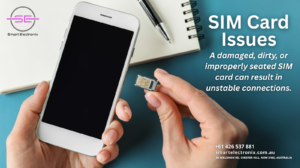
Ever been in the middle of an important call, and suddenly your smartphone signal drops? It’s frustrating, right? Whether you are streaming, working remotely, or just chatting with friends, losing signal can throw off your day. At Smart Electronics, we understand how crucial a stable connection is. In this blog, we will explore the most common causes of smartphone signal dropouts and provide practical tips to improve connectivity.
What Causes Smartphone Signal Dropouts?
Signal dropouts occur when your device temporarily loses connection to the network. This can result in calls being dropped, slow internet speeds, or apps failing to load. Understanding the underlying causes helps you troubleshoot and prevent future issues.
1. Weak Network Coverage
One of the most common reasons for signal dropouts is weak cellular coverage. If you are in a rural area, underground location, or building with thick walls, your smartphone may struggle to maintain a strong connection. Even in urban areas, certain spots can have poor coverage due to distance from cell towers.
2. Network Congestion
During peak hours or in crowded events like concerts or sports games, the network may become congested. Many devices trying to access the same tower can overwhelm the system, causing intermittent drops or slow data speeds.
3. Outdated Smartphone Software
Your phone’s operating system and firmware play a crucial role in maintaining network stability. Running outdated software can lead to bugs, inefficiencies, or compatibility issues that affect signal strength. Regular updates from the manufacturer often fix these problems.
4. SIM Card Issues
 A damaged, dirty, or improperly seated SIM card can result in unstable connections. Sometimes, simply reinserting the SIM card or replacing an old one can resolve frequent dropouts.
A damaged, dirty, or improperly seated SIM card can result in unstable connections. Sometimes, simply reinserting the SIM card or replacing an old one can resolve frequent dropouts.
5. Hardware Problems
Physical damage to your phone, especially to the antenna or internal components, can weaken the signal. Exposure to water, drops, or extreme temperatures can compromise your device’s ability to connect reliably.
6. Interference from Electronics
Other electronic devices, like Wi-Fi routers, microwaves, or Bluetooth gadgets, can interfere with cellular signals. The stronger the interference, the more likely your smartphone may experience dropouts.
7. Carrier Network Issues
Sometimes, signal problems are beyond your control. Carrier maintenance, tower outages, or technical glitches can temporarily disrupt service in certain areas. Checking with your provider can confirm if the issue is widespread.
Tips to Improve Smartphone Signal
Even though some causes are external, there are several strategies to boost your smartphone connectivity.
1. Move to a Better Location
Simple but effective. Moving closer to a window, higher floor, or outdoor space can significantly improve reception. Avoid basements or areas surrounded by thick walls whenever possible.
2. Enable Wi-Fi Calling
Most modern smartphones support Wi-Fi calling. If cellular coverage is weak but Wi-Fi is strong, this feature allows calls and texts to route through the internet, preventing dropped calls.
3. Update Software Regularly
Keeping your phone’s operating system and apps updated ensures optimal network performance. Manufacturers release updates that fix bugs affecting connectivity and enhance signal handling.
4. Check and Replace SIM Card
Inspect your SIM card for damage or dirt. Gently clean the contacts and reinsert it. If dropouts persist, request a replacement from your carrier.
5. Limit Interference
Keep your phone away from other electronic devices that can cause interference. Sometimes, turning off Bluetooth or relocating your router can help reduce signal issues.
6. Use Signal Boosters
Cellular signal boosters can amplify weak signals in your home or office. These devices capture available network signals and retransmit them inside buildings, providing a more stable connection.
7. Contact Your Carrier
If dropouts continue, check with your service provider. They can check tower status, provide network insights, or suggest switching to a different band or frequency for better coverage.
Preventing Signal Dropouts in the Future
- Monitor Coverage Maps: Check your carrier’s coverage maps before moving or traveling to ensure strong reception.
- Regular Device Maintenance: Keep your phone updated and protected from damage.
- Optimize Device Settings: Switch between 4G, 5G, or LTE modes depending on network availability.
- Use Reliable Accessories: Avoid third-party chargers or cases that may interfere with your device’s antenna.
The Role of Smart Electronix in Connectivity

Investing in high-quality devices, accessories, and tools from Smart Electronix can improve your overall experience. From protective cases that don’t block signals to certified signal boosters, using reliable electronics ensures your phone maintains stable connectivity wherever you go.
Conclusion
Signal dropouts can be irritating, but they are usually solvable. By understanding the common causes, maintaining your smartphone, and using the right tools, you can minimize interruptions and enjoy a seamless connection. Whether it’s weak coverage, network congestion, or device issues, Smart Electronics tips help you troubleshoot and prevent most common problems.
Remember, a stable smartphone connection is essential for communication, productivity, and entertainment. Implement these strategies, and you’ll spend less time frustrated by dropped calls and slow internet and more time connected to what matters most.
